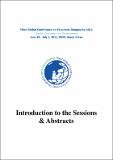| dc.description.abstract | Only a year ago, East Africa was the last major region on Earth without fibre-optic broadband Internet
connections. People were forced to rely on painfully slow and prohibitively expensive satellite connections.
However, the recent arrival of three submarine fibre-optic cables into the Indian Ocean port of Mombasa has
now fundamentally altered the connectivity of the region. The expectations for the cable are high. Tanzania‘s
President, Jakaya Kikwete, for example, sees the cable as a way to allow East Africans to ―become part of the
global economy.‖ However, such projections are often made in the absence of data about current East African
communications practices. This paper therefore aims to address the changing communications ecology and the
effects of the region‘s newfound connectivity. It focuses on a sector of Kenya‘s economy that has been touted as a major growth area and has been assigned a central role in Kenya‘s long-term national development plan:
business process outsourcing (BPO). The paper presents initial results from the first stage of a multi-year project.
Three data sources are compared: discussions of the economic effects of the cables in local and foreign media,
mentions of expected effects of the cables in Kenya‘s national development plan (Vision 2030), and a series of
interviews with managers of small and medium enterprises in the BPO sector. The paper specifically addresses
the following five research questions: (I) how are the potential effects of the East African fibre optic link
represented in political and public discourse within Kenya and Rwanda?; (II) how are ICTs, including mobile
devices, old satellite and new broadband Internet connectivity, variably integrated into value chains and flows of
knowledge, commodities and capital?; (III) are there any observable innovative uses of broadband connectivity
or unexpected challenges to broadband use?; (IV) how are changes in the use of methods of communication and
Internet access linked to altered socio-economic conditions of economic actors?; and (V) how do those changes
differ from academic, public and political discourses surrounding potential effects? While huge sums of money
have been invested to bring broadband to East Africa, largely to encourage economic growth, very little
empirical research has been conducted to examine the effectiveness of Internet connectivity as a tool of
development. As such, it is hoped that this paper can contribute not only to debates surrounding connectivity and
Internet access, but will also provide the beginnings of a robust evidence base crucial in shaping future rounds
of ICT related development projects in low-income countries. | en |


